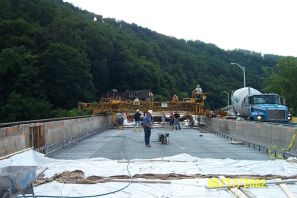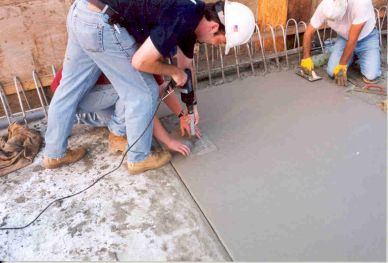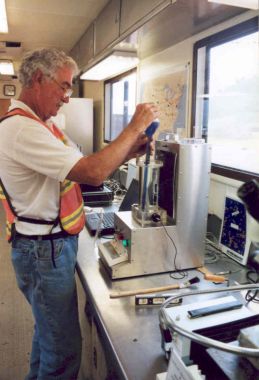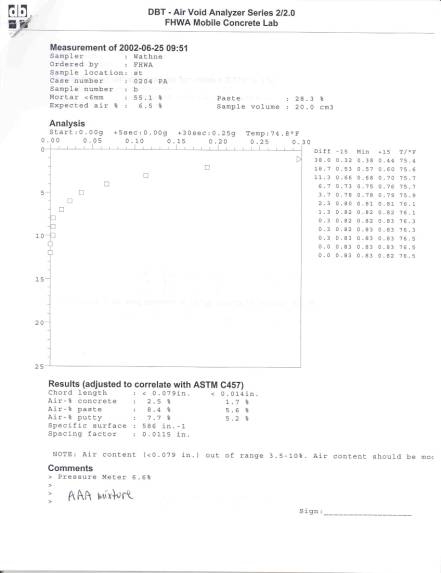MCL Project Reports
Summary Report Kernville Viaduct HPC Deck Concrete 0204
Johnstown, PA Summer 2002
This report presents the results from a limited concrete materials test program conducted by Federal Highway Administration's (FHWA) Mobile Concrete Laboratory (MCL) for a HPC bridge deck replacement in Johnstown, PA during the week of June 24, 2002. The Kernville Viaduct is a 3300 foot, 4-lane, 27 span composite bridge along State route 56 between the Bedford and Napoleon street exits. Figure 1 shows construction in progress on the eastbound lanes (photo courtesy Dave Tepke, PSU). The westbound lanes were completed in 2001, but exhibited substantial signs of early age cracking. In an effort to address this issue, PennDOT employed the assistance of Pennsylvania State University (PSU) to review and document the construction process and comment on improvements that can reduce the cracking and increase the life expectancy of the eastbound deck. Due to scheduling difficulties and batching problems with the HPC mixture, only one small hand placement of the regular PennDOT AAA mixture was completed during our stay on-site.
At the request of PSU staff, a test plan was devised that included demonstration of the air void analysis (AVA) for comparisons to both pressure meter tests and linear traverse measurements. AVA testing was performed on two samples retrieved from the finished deck surface. Slump, air and temperature tests were also performed on site. One concrete cylinder was also cast from this deck concrete for subsequent hardened air content testing at FHWA's Turner Fairbank Highway Research Center.

Figure 1: Concrete placement on the eastbound lanes
Air Void Analysis Testing:
Testing the air content in concrete is important to ensure that the concrete will be freeze-thaw durable. For a concrete to be freeze-thaw durable, it typically needs to contain from 4 to 8% air by volume, uniformly dispersed in small bubbles throughout the volume of concrete. On-site pressure-meter testing is routinely used to measure the total entrained air content. Although pressure meters are effective in determining the total air content, it does not indicate how that volume of air is distributed throughout the concrete. Even though research has shown that it is vital for adequate freeze thaw performance to characterize the air void system in this manner, there are currently no standardized test methods to determine these properties on fresh concrete. The only standardized method to determine the air void system is to run a linear traverse or modified point count (MPC) as prescribed in ASTM C457. Unfortunately, these tests are performed on hardened concrete, and typically take several days to complete, when the concrete most likely already has traffic on it. These tests are also expensive and are generally performed to determine the cause of premature deterioration, not to prevent it.
In an effort to address this issue, researchers in Denmark designed the Danish Air Void Analyzer (AVA). The AVA measures the entrained air content, spacing factor and specific surface of the plastic concrete in less than ½ hour. This allows the concrete producer or contractor to adjust the mixture proportions/mixing procedure in real time, to ensure a proper air void system. The basic principle of the test is to expel all air voids (bubbles) present in a given concrete sample, collect the air bubbles and record their quantities and size distribution. The test involves retrieving a sample of fresh paste, and injecting it into a column of a special analysis liquid. The viscosity of the liquid allows the individual air bubbles to retain their original size, i.e. neither coalesce nor collapse while the sample is injected in to the liquid. The air bubbles then rise through the viscous liquid and enters a column of overlaying water. They rise through the water column and collect under a submerged buoyancy recorder. The rising speed of the air voids through the liquids is dependent on their size (according to Stoke's Law), as large bubbles rise faster than small ones. The viscosity of the analysis liquid slows the initial rise of the bubbles and provides a measurable separation in time between the arrival at the top of the column of bubbles of different sizes. From this data, the air void parameters (air content, spacing factor, specific surface) can be calculated. Figure 2 shows MCL staff sampling the deck concrete for AVA testing, and Figure 3 shows MCL staff using the AVA apparatus.
Unfortunately, only one of the two AVA tests conducted was successful due to the mortar temperature being out of range. The test method relies on a specific fluid viscosity, and this is controlled via the fluid temperature. When the fluid (and mortar) temperature is out of range, the test results are invalid.

Figure 2. AVA sampling under way

Figure 3: Air Void Analyzer being prepared for testing
After completion of field activities, the modified point count test (MPC) was performed on a 4x8 inch cylinder representative of the in-place concrete at the point of AVA test. Figure 4 and Table 1 show the test results from the AVA and MPC, respectively. The MPC and AVA results show good agreement in terms of spacing factor and specific surface (generally regarded as the two most significant indicators of the durability of the cement paste matrix to freezing and thawing exposure of the concrete). The AVA indicated a spacing factor of 0.012 inches and a specific surface of 586 /inch, while the MPC indicated 0.012 inches and 413 /inch, respectively. This good agreement is well within the expected repeatability of either test method.

Figure 4: Air Void Analysis results
| Traverse area (in2) | 11 |
|---|---|
| Traverse length (in.) | 90 |
| Total points counted | 1350 |
| Air (%) | 5.1 |
| Paste (%) | 29.7 |
| Fine Aggregate (%) | 29.2 |
| Coarse Aggregate (%) | 36.0 |
| Total Voids Counted | 475 |
| Mean Chord Length (in.) | .0097 |
| Voids per inch | 5.3 |
| Specific Surface (in2/in3) | 413 |
| Spacing Factor (in.) | 0.012 |
The volumes of air (%) do not correspond directly, as the AVA only includes air voids of a diameter of 3mm or less, while the modified point count includes air voids of all sizes (as does the pressure meter method - ASTM C231). The difference between air volume (%) results from the AVA and MPC would conceptually be considered "entrapped' air (air voids with a diameter larger than 3mm). The AVA results indicate an entrained air content of 2.5%, while the modified point count results indicate a total air content of 5.1%. This would translate to an entrapped air volume of 2.7% - this is higher than typically expected for a AAA mixture with these aggregates.
Conclusions:
Based upon the limited field and laboratory testing conducted in connection with the construction of the Kernville Viaduct during the summer of 2002, we see that the AVA results agree well with the MPC results and may therefore be considered a viable means of determining the freeze-thaw durability of the concrete, during construction. It should be emphasized that this is based upon only one (1) valid test, and although the results are very encouraging, more testing is required to draw a meaningful conclusion.
If you have any comments or questions about these findings/results, please contact Geoffrey Kurgan, Concrete Materials Engineer with the FHWA Mobile Concrete Laboratory at (202) 366-1335 or geoffrey.kurgan@fhwa.dot.gov.
Note: Results from the second, invalid AVA test (because the temperature drifted out of range) indicated a spacing factor of 0.017inches, a specific surface of 449 /inch, and an entrained air volume of 1.9%.

